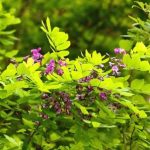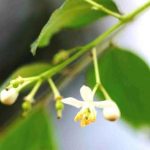TREE LIFE
November 1998
MASHONALAND CALENDAR
Tuesday 3rd November. Botanic Garden Walk. For a change we thought it would be interesting to have a look at the economic section in the Gardens i.e. tea, coffee etc. We will meet Tom in the car park at 4.45 for 5 p.m. – there will be a guard for the cars.
Sunday 15th November. To a section of woodland along the river below the Masembura Dam wall in the Bindura area. A number of interesting species were recorded on the recce. Driving time is about 1½ hours. Bring lunch for an all day outing.
Saturday 21st to Friday 27th November
An invitation is extended to members of the Tree Society to join a group of South African amateur botanists and indigenous plant growers on a trip in Zimbabwe. For details see end of this newsletter.
Saturday 28th November The site for Mark’s Botanic Walk is 100 acres of very fine woodland on the Alpes Road, by kind permission of Sue Garnett. We will meet as usual at 2.30 p.m.
Tuesday 1st December. Botanic Garden Walk.
MATABELELAND CALENDAR
Sunday 1st November – meet at Girls’ College car park at 8 a.m. for an 8.30 start on a morning only visit to a special spot off Circular Drive.
BOTANIC GARDEN WALK: 6 OCTOBER 1998
The genus Grewia – Part 2. Today Tom wrapped up the genus by examining the remaining species growing in the Gardens.
To start with white-flowered species first Grewia lepidopetala has fruits with 2-4 lobes. The leaves are narrow and have a rather membranous feel. This is a rare species, which has been seen by Tom on schist from the Mudzi area into Mozambique. It has also been found at low altitudes in the SE. Grewia tenax, confined to the extreme south of Zimbabwe we had seen on an earlier walk – it has very small leaves, which are as rough as sandpaper.
Another white-flowered species is Grewia sulcata. On the specimen in the gardens the flowers had finished but we had seen them on an earlier occasion. It has obovate leaves that are only slightly oblique at the base. The specific name means “furrowed”, which appears to be a reference to the “androgynophore” (which bears the male and female parts of the flower), which is sulcate in this species.
Turning to the more numerous yellow-flowered species, we looked at Grewia inaequilatera. This has unlobed fruits and leaves with are markedly asymmetrical at the base, which is probably what is meant by the specific name. Grewia micrantha was, sadly, almost leafless at this time of the year but we could just make out that it had asymmetrical leaves that are grey underneath. It is generally a low altitude species.
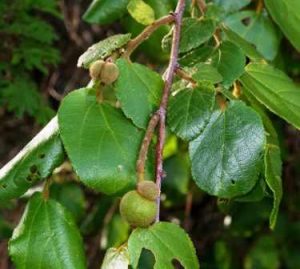
Grewia hexamita. Photo: Meg Coates Palgrave. Source: Flora of Zimbabwe
Grewia hexamita is a distinctive species with large leathery and shiny leaves. Its fruits are exceptionally large and are 2-lobed. This occurs in the extreme S of Zimbabwe, east from Beitbridge. Grewia villosa has very villous, almost quilted, leaves that are serrated. The fruits are 4-lobed. It is a small shrub and is quite widespread at low altitudes. Finally, we paid a visit to the nursery to see a small flowering Grewia flava. It is a rather local species recorded from dry woodland in the south and west.
Apart from Grewia, Tom also showed us Rhus lucens, which occurs in the Victoria Falls and Deka River areas in dry ravines. It is a dense bush to 8 metres with exceptionally glossy leaves (the specific name means shining).
In addition, someone had collected a white flower form a tree near the car park. This was Caloncoba welwitschii from Malawi – it does not occur in Zimbabwe. It had leaves clustered towards the ends of the branches and the large, somewhat Oncoba like flowers borne on older wood below the leaves. The petals are large and white and the flower has 3 sepals. Like Oncoba, it belongs to the family Flacourtiaceae.
As usual, a most interesting session and our thanks go to Tom for his usual patience.
-Mark Hyde
DRYMARIA CORDATA AT VAL D’Or
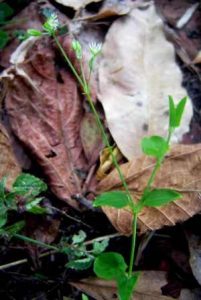
Drymaria cordata. Photo: Bart Wursten. Source: Flora of Zimbabwe
On Saturday 26th September 1998, the Tree Society visited Bill Clarke’s property in the Arcturus/Ruwa area. Just in front of the house is a stream system with a dam and just below the dam is a swampy area, which was damp even in the dry season. In the shade of some fine Syzygium trees, we found a prostrate creeping herb, Drymaria cordata.
This species belongs to the family Caryophyllaceae. It has ovate to almost circular leaves, arranged opposite one another along the stems, with stipule like fimbriae arising between each pair. The flowers are small and white and arise on diffuse inflorescences.
Drymaria cordata is fairly common in the Eastern Highlands where it grows in high rainfall areas, on forest edges and roadsides. It is also widespread in similar high rainfall areas in Africa. However, within Zimbabwe, it has never before been recorded outside the Eastern districts.
In this particular area, there were a number of garden plants and I wondered whether Drymaria was ever cultivated. This seems unlikely, but it could conceivably be planted for ground cover. However, there are no cultivated specimens in the National Herbarium, nor have I come across it in an admittedly quick search of the gardening literature.
Finally, our thanks go to Bill Clarke and his wife for allowing us to visit such an interesting spot and for the welcome tea and cakes afterwards.
-Mark Hyde
BOTSWANA SAFARI
I have no reason to disagree with the claim that the Mopane (Colophospermum mopane) is the most plentiful tree south of the Zambezi/Cunene Rivers having recently motored to Maun and Chobe in Botswana. Mopane scrub or woodland dominates all the way from Plumtree, where one leaves Zimbabwe, to Maun except for the extensive Makgadikgadi Pan system, which has an open grassland perimeter surrounding the sodic pan floor.
Having spent my schooldays at Plumtree in the 40’s when Plumtree and Francistown were more or less on a par, it was revealing that, whereas in the interim Plumtree has hardly progressed, Francistown is now a bustling commercialised town with a serious traffic density problem. The Tati River runs through Francistown, a dry bed of sand. Interestingly, Alice Balfour in her account “Twelve Hundred Miles in a Wagon” painted a scene on the Tati in 1894 showing the river heavily silted which was long before grazing mismanagement could be blamed!
Nata, 190km northwest of Francistown through endless Mopane scrub, is no more than a refuelling stop where the road branches to Maun on the Okavango Delta 305km to the west, and Kasane 312km to the north on the Chobe. The Nata drains a large area northwest of the Plumtree – Marula watershed including the Tegwani river system, and is a bit of an oasis where it enters the Makgadikgadi Pans since the trees have access to water below the sand. We slept under a fine Acacia galpinii with Fan Palms (Hyphaene petersiana) and giant Marula (Sclerocarya birrea) in attendance together with the ubiquitous Ziziphus mucronata.
Thomas Baines, Explorer and Artist, passed that way on foot in 1862 and painted a cluster of seven large Baobab (Adansonia digitata) growing on the edge of a pan of the Nxai system. Being the possessor of a print of his well-known painting, I was keen to see the trees.
We struggled through about 20km of deep Kalahari sand best suited to high clearance 4x4WD, with a view of a solitary Oryx on the way. The Baobab are in pretty good condition and well protected by the Botswana authorities, and presumably in much the same condition as Baines found them nearly 140 years ago. Given the extreme difficulty of traversing such tracks, the site is now a popular visiting point with the emergent Outdoor Living 4x4WD touring enthusiasts who are well acquainted with the technology of getting through the miles and miles of such sand – partially deflating tyres, scrub corduroys for better purchase over the sand, keeping engine revs up, etc. They often go in convoy with other 4x4WD enthusiasts for mutual assistance with tow ropes and shovels when necessary. There is clearly a cult developing among these enthusiasts as to who can traverse the worst roads successfully and Botswana is a happy hunting ground.
There are two classes of road in the region. Excellent fully tarred highways covering huge distances link the main centres. Off these highways the tracks are mostly impassable to conventional two wheel drive vehicles due to the structureless deep Kalahari sands or to deep basalt clays, which are the two principal geological types. Interestingly, when wet, the sands are firmer and passable while the basalts are grease pots when wet but quite firm in the dry season although very dusty. The sands are treacherous when dry and hot and become worse if used a lot. The wheel tracks become deeper and the ‘middle mannetjie’ ridge becomes higher. Hence the need for high clearance, ‘fat tackie’ tyres, and four-wheel drive preferably with no trailers.
Maun, again a bustling commercialized centre serving the tourist trade, was memorable to myself in respect of two tree species. On the deep Kalahari sand of this semi desert region receiving no more than 250mm of rain per annum, Terminalia prunioides featured strongly sporting a rich cover of purple pods that showed up particularly splendidly in the evening light. Boscia albitrunca was also well adapted and I was disappointed not to find a true Bushman resting under each one. Other species present included Acacia tortilis, Acacia erioloba, Croton megalobotrys, Ziziphus mucronata, and Colophospermum mopane.
Maun (the ‘place of reeds’ in the vernacular we were told), lies astride the Boteti river channel, which drains the Okavango swamps in years of good spillage depending on the rainfall along the Okavango River and its catchment in Angola and Caprivi. For years I had looked forward to seeing the Moremi Game Reserve but frankly I found it a bit frustrating in that being so flat and featureless one could not get a view of the extent of the swamp areas. It is, after all, the extensive bed of an ancient shallow lake best seen from the air. In the riverine fringe adjacent to the water channels Kigelia pinnata showed a very clear and elevated browse line from elephant or giraffe, I was not sure which. Other principle species included Faidherbia albida, Acacia erioloba (but no camels), and a new one for me, Acacia hebeclada with its bivalve whitish pods, and Hyphaene petersiana, as well as Lonchocarpus capassa, and Combretum imberbe. Away from the riverine there was some fine Mopane woodland but unfortunately devastated by an excess of elephant, as we have seen so commonly elsewhere in our region. Acacia nigrescens was occasionally present as well. Tourists go to Moremi mostly to see game and apart from the usual we saw a Cheetah and her two cubs, Lechwe, and Tsessebe.
Our itinerary then pointed to Savuti Camp 213km to the northeast as our next stop. Once again we were in the hands of the adventurous 4x4WD clan over tracks very demanding of the vehicles. I tend to think of a vehicle as a beast of burden not to be overtaxed but to these overlanders, it is no more than high-tech fabrication capable of hour upon hour of heavy going, never tiring, as a beast would do. The route took us through Mopane and Acacia Woodland with some open grassland adjacent to a large basalt vlei. The camp is spread out in bushland, undeveloped save for a single water point and several hundred yards away a single and very crude longdrop. The Hyenas were in constant attention all night throughout the camp and one approached to within a yard of my sleeping bag before being “voetsacked” by my daughter who lay awake on guard. Next morning, Red-billed hornbills, Yellow-billed hornbills, and Red-billed Francolin foraged around at out feet for breakfast scraps showing no fear of us at all. Why can’t they be like that everywhere?
Next leg we continued on similar nightmarish tracks but, with the rainfall regime evidently improving as we moved north-eastwards, mopane and Acacia woodland gave way slowly to Baikiaea plurijuga woodland as we know it in the Forest Reserves on the Kalahari sands of the Victoria Falls area. Our destination was the Serendela camp on the Chobe with its extensive floodplains north of the river, treeless and supporting thousands of elephant and buffalo. Again a feature of the wildlife in this locality was the evident fearlessness of Man. Impala stood trustingly by the roadside and a Heuglin’s Robin continued with its ablutions in a cup-sized puddle within arms reach of where I stood!
After a little more sand, it was full tar to Kasane from where we flew per favour of son-in-law, Dominic, to Bumi Hills area of Kariba. I am always a trifle shocked at the way the arid bushland of Kariba comes down to the lake water line with no sign of a “coastal woodland fringe” even though the lake has existed for nearly 40 years. Admittedly a few Acacia tortilis have encroached into the shoreline in places but generally the change in ecological terms is very abrupt from the wetted zone of the present water level and the arid open woodland and scrubland of what the area was like before the lake was built. The commonness of Tamarindus indica reminded of ancient trading exploits from Asia while the ever-present Ziziphus mucronata pressed home the point of how wide¬spread this species is. According to the books it occurs from Port Elizabeth in southernmost South Africa to Zambia and through to Namibia – quite a spread of climate and soils!
In retrospect this journey, whilst interesting and enjoyable, reiterated how fortunate we are in Zimbabwe with our extensive and diverse tree life doubtless on account of the wider range of climates of our region and the lack of serious frost. Few of the tree species we encountered had me guessing too long given a fair knowledge of the Zimbabwe woodlands but some did elude me even equipped with up to date reference books. Our party was composed mainly of game-seeking people, with long distances to travel each day. Making and breaking camps, cooking and washing up, and the inevitable pushing and digging vehicles out of those sands, became the priorities. However, the generally arid climate meant a relatively small spectrum of tree species most of which are well known to Zimbabweans particularly those who know their Lowveld trees.
-John Wilson
GOROMONZI – 20 SEPTEMBER 1998
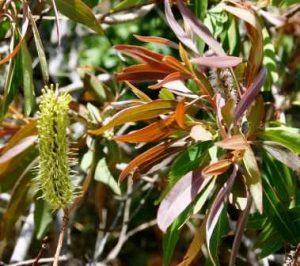
Faurea saligna. Photo: Bart Wursten. Source: Flora of Zimbabwe
This area, known as Belvedere and which has the Chinyika River as one of its boundaries, has the typically highveld vegetation of mixed Brachystegia woodland with scattered termitaria. Initially our walk followed the path below the dam wall where Msasa and Faurea saligna were dominant and hopefully after so many of these two species, nobody who was on this walk will forget them!
Generally watercourses are more attractive than dry slopes and an insignificant rock strewn path took us to a pleasant riverine patch almost totally dominated by Myrica serrata. If a close look is taken at the serrated leaves it is easily noticed that the lower surface is covered with tiny golden resinous spots, which also produce a strange odour when disturbed. Father Ross watching out of the corner of his eye at the crush and sniff tactics, noted from his copy of Bob Drummond’s green book that the fruits were boiled up and rendered down to form candles in old South Africa – might be something in this in the light of our bungee dollar!
Another find here with pale pink buds was none other than the Bushman’s Poison, Acokanthera oppositifolia, more common in the areas east of Harare and looks somewhat like the more familiar Num Num – Carissa edulis. A comparison of the two reveals no spines and darker green coarse leaves for the toxic one, fortunate perhaps as the two often grow close together and a mistake could result in a “fatal error”. A diversion here with a Red-headed Weaver making early attempts at a new nest overhead on an electricity cable, this caused Adrian Lind on the adjacent slope to think we had tired of plants and were looking at power lines instead.
The rather abrupt arrival of summer this year induced lethargy and while some of the others invigorated by country air investigated what seemed to be an ‘island’, the rest of us ambled back noting various avian activities returning in time for a noon day refresher.
The afternoon walk with only four of us following a meandering path through the woodland and termitaria above the lodge produced a reasonable variety of species ranging from climbers to large trees. For the climbers, one we’ve all experienced one way or another is Pterolobium stellatum, the incredibly spiny stems and the delicate pink fruits hanging limply eases identification. A plant of this nature should find reference in any handbook on home security.
Apart from the tall canopy woodland two other species, which drew comment for their size, were Diospyros mespiliformis and (Cassine) Mystroxylon aethiopicum. Both took some time to identify as the foliage was far out of reach and my wildly inaccurate stone throwing caused alarm and consternation, finally we achieved success by resorting to throwing a stick.
Many thanks to the Wingfields for the outing and also for having had the lodge opened for those who wished to view the inside. Although we only covered a relatively small area, 76 species of trees were noted.
-Andy MacNaughtan
The ‘island’, which was turned out to be an anthill connected to the mainland by a causeway, produced an amazing number of species, the most interesting being Cadaba termitaria in flower, Maytenus heterophylla in flower and on the damp ground, many very young Acokanthera oppositifolia, probably sprouting from the roots of the mature plants. Back on the mainland near this anthill were Carissa edulis laden with exceptionally large red fruit, and on a dead tree stump was a thriving huge Ansellia gigantea the ‘leopard orchid’ with both buds and fully opened flowers.
Earlier this group was delighted to see several flowering terrestrial orchids (probably) Eulophia callichroma. The flowers were greenish with a white frill on the lip; and flowering very close to the ground, a brilliant crimson Hibiscus rhodanthus – this happy little plant flowers from the woody root stock, before its leaves appear.
IN SIGNIS AND IN HEALTH
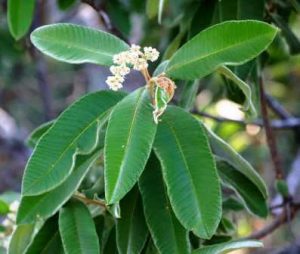
Ozoroa insignis Photo: Bart Wursten. Source: Flora of Zimbabwe
At a recent Tree Society outing we came across a specimen of Ozoroa insignis and it was pointed out that this tree is much esteemed by the local herbalists and n’angas for its medicinal properties. At this Dr John Wilson was heard to mutter “insignis and in health”
Later on John Cottrill congratulated the good doctor on this shaft of impromptu wit and in the course of the ensuing conversation John Wilson referred to John Cottrill as a dendrologist.
John C then retaliated by announcing in a tone of mock indignation that he was Church of England and NOT a dendrologist!
Wit in the Woodland? Or was it?
As a matter of interest, Dr. Gelfand, in his book The Traditional Medical Practitioner in Zimbabwe, lists not less than 15 symptoms and diseases which parts of this tree are used for. These include; diarrhoea, constipation, tapeworm, bilharzia, backache, infertility in women, and for use as an aphrodisiac. No wonder that many specimens of this tree which we come across have had portions of their bark removed…
-John Cottrill
Proposed itinerary of the Plant Life excursion to Miombo Woodland in Zimbabwe.
Saturday 21 November. Arrive Lake View Holiday Resort
Sunday 22. Lake Kyle Area
Monday 23. Great Zimbabwe Area Tuesday 24 Travel to Harare
Wednesday 25. Mukuvisi Woodlands; Seke and Harava Dam Reserves
Thursday 26. Botanical Garden and Herbarium and Christon Bank Botanical Reserve
Friday 27. Great Dyke
Saturday 28. Return home.
Lake Kyle Holiday Resort – 3 nights – Chalet = Z$230 p.p./p.n. = $690.00 or camp/caravan = Z$35 = $105.
Own breakfast: Own lunch (can supply rolls/bread and fillings). Communal evening meal = $50 p.p. = $350 for whole week.
Tree Society members are invited to join the South African visitors on all or part of the trip. Meg describes the group as enthusiastic, knowledgeable and very interested in plants, and local support would be most welcome.
Please contact Meg Coates Palgrave
ANDY MACNAUGHTAN CHAIRMAN


